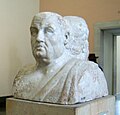Villa Celimontana
The Villa Celimontana , also called Villa Mattei , is a park in Rome .
location
The park covers large areas on the southwest side of the Celio hill and extends into the Valle delle Camene, opposite the Caracalla thermal baths . The site belongs to the Celio district . The main entrance is on Via della Navicella next to the Basilica of Santa Maria in Domnica . A side entrance is on the Clivo di Scauro opposite the Basilica of Santi Giovanni e Paolo . Part of the area is now taken up by the municipal nursery.
history
In ancient times, the site was on the edge of the Servian Wall south of Porta Caelimontana, today's Dolabella Arch . It was a densely populated residential area that was destroyed by the fire of Rome in AD 64 . After that, luxurious domus emerged . In the north-eastern part of today's villa was the barracks of the 5th cohort of the vigiles .
In 1553 the site, now a vineyard, was acquired by the Roman nobleman Giacomo Mattei from the Paluzzelli family. But only his relative Ciriaco Mattei commissioned the architect Giacomo del Duca in 1581 to design the park and the so-called casino for the first time. In the following years Giovanni and Domenico Fontana worked on the design. Gian Lorenzo Bernini designed the fountain .
After the Mattei family sold the property to Manuel de Godoy in 1802 , the owners changed in quick succession. From 1851 to 1855 the villa was owned by Marianne von Oranien-Nassau and her partner Johannes van Rossum . Baron Riccardo Hoffmann bought it in 1869. In 1918 it was expropriated by the Italian state and in 1926 transferred to the city of Rome, which opened the park to the public. The Società Geografica Italiana has been based in the casino since then .
estate
The villa is now a public park, which is only designed as a regular Renaissance park in the southern part. Here is the Obelisco Matteiano , which was given to Ciriaco Mattei in 1582 and placed in the villa. Overturned and broken in the 18th century, it was re-erected on the southern edge of the park in 1820 and the missing parts were added.
The Casino, also called Palazetto Mattei, in the Renaissance style forms the center of the complex and is built on a wide terrace. Various music events take place in the park in summer.
During excavations in the area of the villa, numerous finds were found, most of which are now in the Vatican Museums . A double bust of Seneca and Socrates are shown today in the Pergamon Museum in Berlin .
literature
- Michele D'Innella: Guida Rossa Roma. Touring Club Italiano , Milan 2004, pp. 781-783.
- Manfred Wundram (Ed.): Reclams Art Guide, Italy. Volume V. Rome and Latium . Reclam, Stuttgart 1981, ISBN 3-15-008679-5 .
- Filippo Coarelli : Rome - An Archaeological Guide . Zabern, Mainz 2000, ISBN 3-8053-2685-8 .
Web links
Individual evidence
- ^ Coarelli, Rome - An Archaeological Guide , pp. 206-208.
- ↑ Touring Club Italiano: Guida Rossa , p. 516.
- ^ Villa Celimontana Jazz .
Coordinates: 41 ° 53 ′ 3.2 ″ N , 12 ° 29 ′ 39.7 ″ E





